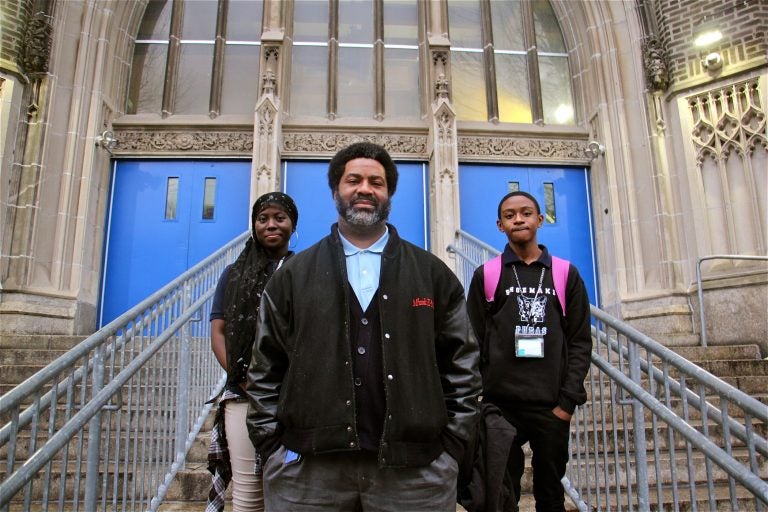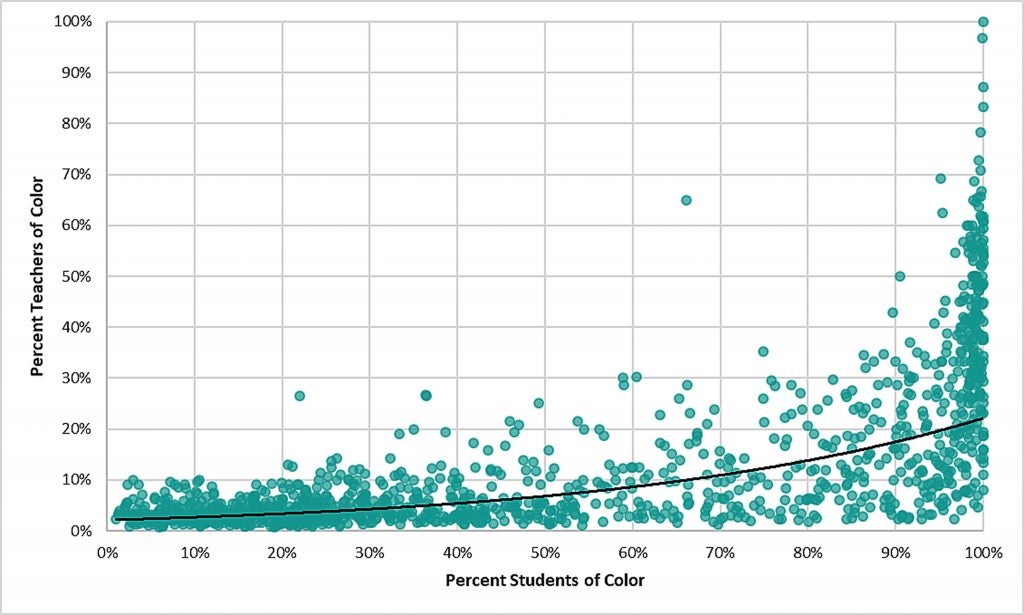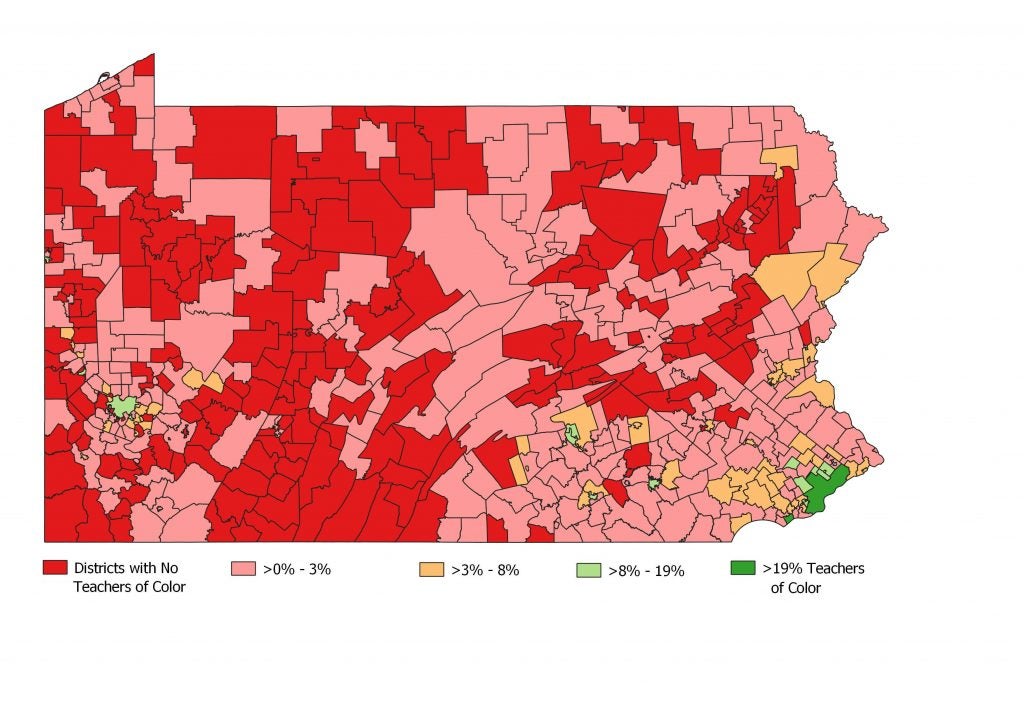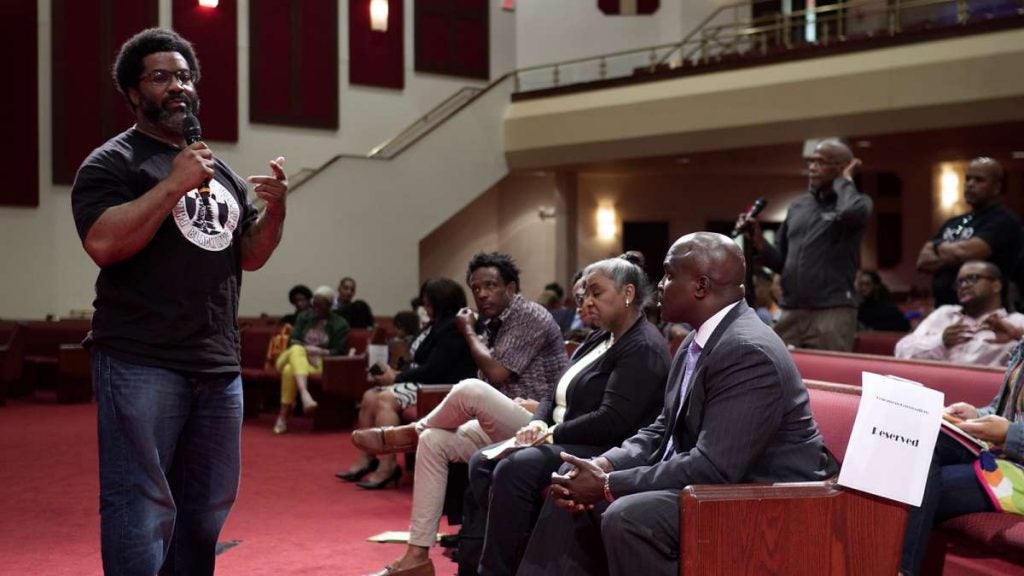More than half of Pa. public schools do not have a teacher of color

El-Mekki, then principal of Mastery Shoemaker Elementary in Philadelphia, pictured in front of the school with two students in 2018. (Emma Lee/WHYY)
More than 60 years after the Brown vs. Board of Education ruling, an analysis of state data shows persistently stark disparities between the racial composition of teachers and students in Pennsylvania’s schools — among the widest gaps in the country.
Just 5.6 percent of Pennsylvania’s teachers are persons of color, compared to 33.1 percent of its students.
The data also show 55 percent of the state’s public schools and 38 percent of all school districts employed only white teachers.
Nearly three in four of the state’s black teachers — 72 percent — work in Philadelphia and Allegheny County, where 54 percent of the state’s black students attend.
But even in these two counties, there is a disparity — 40 percent of the students are black, compared to 14 percent of the teachers.
These numbers are based on information provided by the Pennsylvania Department of Education (PDE) for the 2016-17 school year. The nonprofit organization Research for Action (RFA) created a data set containing the racial breakdown of teachers and students in every school, district, and county in Pennsylvania, as well as summary statistics for the entire state. RFA also published a brief of the main findings to accompany the new data.
RFA also found that black teachers are more likely to work in elementary schools than in high schools.
While PDE has long made available data on student racial and ethnic composition by school, this is the first time that this information has been made available for teachers. The department released the racial data on teachers in response to a records request by the The Philadelphia Public School Notebook, a partner of Keystone Crossroads.
This allows documentation, for the first time, of the extent of these disparities on a school-by-school basis.
This new analysis supplements RFA’s prior policy brief, called “Patching the Leaky Pipeline,” on recruiting and retaining teachers of color across Pennsylvania.
Studies show that students of color, black students in particular, benefit from having teachers who look like them, said Erica Frankenberg, an associate professor of education at Pennsylvania State University who has researched desegregation and diversity.
White students also benefit; it is crucial to have diverse viewpoints in all schools, Frankenberg said. Teachers of color bring added perspectives and influence everything from curriculum choices to what music the band or orchestra plays.
In faculty meetings, “they bring up issues that white teachers may not have had in their experience. Most white teachers grow up in segregated environments,” she noted.
Jeffrey Ulmer, director of human resources in the West Chester Area School District, affirmed the need for teachers of color “to give their cultural experience and a different worldview.” White students make up 78 percent of West Chester’s enrollment; five percent are black.
“Once our kids are in the real world, they are not going to deal with just the white population,” he said. “They have to work, share, and grow with people of all cultures, colors, creeds, and denominations.”
RFA’s brief cited research showing that a diverse cadre of teachers leads to higher expectations and better outcomes for students of color, including an increase in graduation rates. Having teachers of color on staff also improves school climate and a reduces “implicit bias” in decision making.
According to a recent University of Pennsylvania study, the nation as a whole is increasing the supply and the diversity of its teachers.
But this is not happening in Pennsylvania. Philadelphia’s teaching corps is growing more white, according to the state data. And suburban districts around Philadelphia, even those with high black student populations, are having trouble recruiting teachers of color.
The trends cited in the study were tracked over a 30-year period and “vary across jurisdictions,” said Richard Ingersoll, the Penn study’s lead author.
The Pennsylvania Department of Education realized the need for diversifying its teacher corps in its plan for implementing the federal Every Student Succeeds Act (ESSA). It was one of only six states to make recruitment of teachers of color a priority.
Reaching this goal, however, is becoming more difficult in Pennsylvania, where the number of people of any background who pursue teaching careers is plummeting. Between the 2009-10 and 2015-16 school years, the number of teaching certificates issued in the state dropped from 14,247 to 4,412.
The ESSA plan notes that while the number of graduates in the state earning teaching degrees has decreased by 39 percent since 2000, African American graduates in education have decreased by 71 percent. In 2014, for instance, just 29 African American men and 20 Latino men obtained teaching degrees in the state.
This decline can be seen starkly in Philadelphia. In 2001-02, one in three Philadelphia teachers – 34 percent – was black. Today, the number is at 23 percent.
The chart below shows the percent teachers of color compared to the percent students of color in Pennsylvania public schools that had at least one teacher of color in 2016-17.

The statewide picture
Across Pennsylvania, many of the whitest schools have an all-white teaching force, whereas schools with more students of color usually employ a higher percentage of teachers of color.
Philadelphia and Chester-Upland are the only school districts in Pennsylvania where less than 80 percent of teachers are white – the number is 69 percent for Philadelphia and 60 percent for Chester-Upland. These two districts also employ the highest proportion of black teachers – 24 percent in Philadelphia and 38 percent in Chester-Upland.
In other school districts, the proportion of white teachers ranges from 81 percent in diverse districts such as William Penn and Cheltenham to 100 percent in more than 200 districts, including Scranton. Out of the 499 school districts in Pennsylvania, 38 percent have no teachers of color. These districts with all white teachers contain almost 20 percent of all the students in the state.
The map below depicts these stats, with the districts without any teachers of color depicted in red.

Harrisburg, the state capital, has one of the lowest proportions of white students among Pennsylvania school districts (3 percent), while 57 percent of its students are black. Yet, only 14 percent of its teachers are black and 84 percent are white.
Asian and Hispanic teachers are also underrepresented across the state. For a student population that is almost four percent Asian and 11 percent Hispanic, only 0.6 percent of teachers are Asian and one percent are Hispanic.
Allentown and Reading are two large school districts that exemplify just how few Hispanic teachers there are. Each district has a large Hispanic student majority, but Hispanic teachers only comprise 3 percent of their teaching force.
This trend is seen even in Philadelphia, where the white student population in public schools is around 15 percent. The data show that schools with relatively high numbers of white students usually have higher percentages of white teachers than the city as a whole. A few have no teachers of color at all.
This trend accelerated after the 2010 dissolution of a court order, enacted during a longstanding desegregation case, requiring that black teachers be represented in each school in rough proportion to their percentage citywide.
The Notebook’s review of the statewide data found that racial disparities are also evident among schools in the Philadelphia suburbs in Bucks, Chester, Delaware, and Montgomery counties.
Just more than half – 52 percent – of the schools in the Philadelphia suburbs have no black teachers.

While urban and suburban schools in Pennsylvania that serve more black students generally have more black teachers, this is not always the case. For instance, the Harambee Institute of Science and Technology Charter School in Philadelphia, which was founded with an Afro-centric focus, has an all-black teaching force and student body. On the other hand, the Urban Pathways 6-12 Charter School in Pittsburgh has an all-white teaching force, even though 98 percent of its students are black.
There are plenty of schools across the state like Urban Pathways with white teachers in classrooms of black students, but none showing the opposite trend – a high proportion of black teachers in predominantly white schools.
Importance of diverse educators
Sharif El-Mekki, principal of Mastery Charter-Shoemaker campus and a founder of the Fellowship: Black Male Educators for Social Justice, a national organization, said that students of color benefit from having teachers of the same race.
“Teachers of color have a tremendous impact on students of color, because they bring a shared sense of responsibility and urgency,” he said.
Black teachers, in particular, are necessary to help black students “develop a positive racial identity and ensure they have the tools to combat all of the negative images and messages they receive about them, their people, and their community,” he said.

But there is another side to the story: researchers say white students benefit from having teachers of color as well.
“In this increasingly diverse country, white students need access to teachers of color so that they can learn how to navigate society,” said Travis Bristol, assistant professor at the University of California, Berkeley. “White children lose out when people think that only children of color need teachers of color.”
Bristol, a former public high school teacher, has produced extensive research on how education policies affect teachers of color.
A lack of Asian and black teachers is seen in Upper Darby, where 15 percent of students are Asian and 47 percent are black. There, only one percent of teachers are Asian and three percent are black. The remaining 96 percent of teachers are white.
Dan Nerelli, former Upper Darby superintendent, said that even so, the district has made significant improvement in diversifying its teacher population.
He said that in 2009, only 1.7 percent of Upper Darby teachers were people of color, compared to four percent in 2016-17. “We almost doubled the numbers – four percent is still not good, but it’s better than 1.7 percent,” he said.
Nerelli described various strategies the district undertook to recruit more teachers of color, including “advertising our jobs…to reach more candidates” and “visiting some historically black colleges, one of which was Hampton University” in Virginia.
But there were still insufficient candidates, regardless of race or ethnicity, who could meet Upper Darby’s need for more special education, science, and math teachers. The overall shortage of teachers, especially in these areas, translates into an even greater lack of teachers of color, making it difficult for districts to increase teacher diversity, he said.
While having teachers of color in predominantly white schools is beneficial, Alice Ginsberg at the Branch Alliance for Educator Diversity believes that it is also important for all teachers to talk about diversity.
“It’s really important that all teachers, whether of color or not, know how to go into a classroom, engage all students, and bring in a lot of different cultural examples to the curriculum,” she said.
Christopher McGinley, a Philadelphia Board of Education member, said that teachers need to have “the ability to relate and connect with people who share their racial identity and people who don’t.”
“Often, people immediately relate better to people who look like them,” he said. “But beyond that initial point of engagement, it has to do with the teacher’s ability to develop a positive rapport with the student.”
McGinley, who served as superintendent in both Cheltenham and Lower Merion, acknowledged that teacher diversity is important for all school districts, no matter the racial makeup of their students. “Just because a district is predominantly white, doesn’t mean it’s a good practice to have a faculty that’s entirely or predominantly white,” he added.
A matter of expectations
Some research indicates that the dearth of black teachers could further perpetuate the achievement gap between black students and their peers. A 2016 study from Johns Hopkins University found that white teachers tend to predict lower levels of academic performance for black students, compared to black teachers.
El-Mekki explained that higher expectations from teachers of color often translate into “a high level of support that can create amazing outcomes for students. On the contrary, when you have low expectations, students don’t do well and we see the results of that across the country.”
He pointed out that in addition to the diminishing pipeline of African American teachers, retaining qualified candidates is difficult. Teachers of color suffer from higher attrition rates because they tend to teach in more challenging schools, where most students come from less privileged communities. Many of these students have suffered from trauma, and transience is more common.
“A lot of black teachers choose to work with black students whom they feel have been marginalized the most, which puts them at schools that tend not to be white at all,” El-Mekki said. “There’s a tendency for them to dive into the biggest fires, but because so many black educators have that fireman mentality, it can also lead to a faster burnout.”
Besides personal exhaustion, inadequate support systems for teachers of color in challenging school environments can also contribute to higher attrition rates.
“A lot of policymakers believe that just by recruiting a teacher of color to work in a challenging school, that person will automatically be successful,” said Bristol, the Berkeley professor.
“But those teachers don’t have the resources or the ongoing professional development that they need to be successful, so they leave those schools at a higher rate compared to their peers.”
The poor physical conditions in school buildings, especially those in low-income districts that cannot afford sufficient repairs, can make teaching even more difficult. Jerry Jordan, the president of the Philadelphia Federation of Teachers (PFT), described various environmental hazards that some teachers constantly face, from the lack of air conditioning on hot summer days to the presence of toxic substances in classrooms.
“It’s very easy for someone to say, ‘I don’t want to do this anymore. I want to go to work, be respected, and treated like a professional,’ so they leave the system,” Jordan said.
Teachers of color who remain in teaching face a new set of challenges that come with navigating race relations in a mainly white profession. They may have to undertake additional responsibilities related to students of color, such as disciplining students or communicating with their families.
Kenneth Hung, a social studies teacher at Central High School and board member of Asian Americans United, has been teaching for 20 years. Hung, who is Taiwanese-American, said that teachers of color were often expected to “deal with every kid of color who looks like [them].”
“I shouldn’t be expected to understand every Asian person from Turkey to Japan…let alone I shouldn’t be the only person to teach Mandarin or be the expert on China,” he said. “There’s a big burden to be the spokesperson, the advocate, and the social worker [for students of color].”
These expectations can result from assumptions about the roles that teachers of color should play in schools. Some may expect East Asian teachers to “have parties where they teach the school how to make fortune cookies,” or for “black male teachers to discipline black kids,” Hung said.
“We need to create environments where teachers of color are valued, but not tokenized, for the perspectives they bring,” he said.
El-Mekki said that the role of disciplinarian is often thrust upon the few male teachers of color by school administrators.
Some supervisors “would send their problematic kids – kids that they struggled with – to the black men on their team and ask them to be the disciplinarian…the black teachers felt they were being held accountable for students misbehaving in other people’s classrooms,” he said.
Since the school environment defines a teacher’s experience, Bristol thinks that principals and even teachers themselves need to understand how racial biases can affect teachers of color.
“Principals need support to understand why these practices are happening, to be aware and attentive to them,” he said. “We also need to help white teachers to understand the varying ways that bias happens in their own building.”
Besides supporting current teachers of color, recruiting more candidates of color into teacher preparation programs is also critical, but educators say this is only possible when teaching is seen as an attractive profession.
“We’re just having a problem getting people who want to be teachers, because public education has taken such a bashing and there has been so much negative press on public schools,” said Mark DiRocco, executive director of the Pennsylvania Association of School Administrators.
PFT president Jordan echoed that. “Teachers have to be shown more respect. Teaching has to be seen and treated as a profession…because it is very important in helping to educate our future [generations].”
WHYY is your source for fact-based, in-depth journalism and information. As a nonprofit organization, we rely on financial support from readers like you. Please give today.





